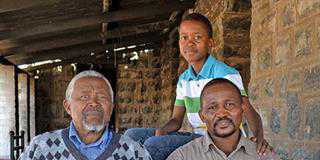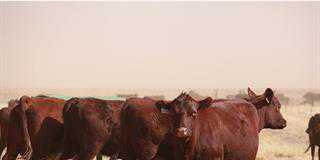
Brothers Horacio and Luis Giraudo have run a commercial dairy operation for 20 years farm in the southern part of Córdoba Province in Argentina. Their Holstein herd numbers 400 cows in milk at peak production off a grazing platform of 330ha of dryland pasture. Despite its relatively small size compared with most South African commercial dairy herds, it is somewhat larger than the average dairy operation in their area. In fact, the average dairy farm in Argentina has only about 140 lactating cows.
In South Africa, a commercial dairy operation only starts becoming profitable at 300 cows in milk, according to the Milk Producers’ Organisation (MPO). Dr Fernando Orias, a vet who advises the Giraudo brothers on herd nutrition, says that Horacio and Luis – who only speak Spanish – started with about 50 cows they milked by hand, on land leased from their parents.
VIEW: Argentina photo gallery
“The herd grew slowly and Horacio and Luis invested in a five-point swing-over milking machine which they installed in the shed where they had hand milked. Five years ago, when there were 300 cows in milk, the Giraudos built a new shed and put in a 24-point swing-over.”
Milking contracters
Typical of Argentinian dairy operations, milking is handled by a milking contractor. There are three milkers who disinfect, cluster up and perform routine checks for mastitis and other health problems. They are also responsible for cleaning and maintaining the plant. The fourth member of the team moves animals between pastures and parlour.
Contractors are paid between 8% and 12% of the gross income of milk sales.
The brothers oversee other aspects of the enterprise, such as cropping, sourcing cropping by-products for feed, mixing rations, breeding and planting. “The Giraudos’ farm is a typical Argentinian operation,” confirms Fernando.
The cows graze almost year-round, largely on lucerne. They are also fed conserved forage (silage), crop by-products and concentrates. In spring and summer the pastures flush providing high quality grazing.
In autumn, when grazing quality drops, it is supplemented with maize and lucerne silage, lucerne hay and concentrate. Winter pastures of oats, wheat and barley provide forage when the lucerne dies back. The pasture/supplement ratio varies seasonally, with more pasture and less supplement in spring and summer, and the converse in autumn and winter. Pasture-based dairy farming requires the farmer to keep balancing available grazing and bought-in supplements, bearing in mind that pasture is the cheapest component of feed.
In late April and early May, high-quality lucerne hay costs approximately 20 centavos/ kg (R0,26/ kg) and maize about 1,20 pesos/kg (R1,57/kg). Silage is usually two to three times the price of grazed pasture.

Vet Dr Fernando Orias (centre) with Luis (left) and Horacio Giraudo.
Production
The Giraudo herd produces about 8 000l milk/ day, which goes up to about 10 000l/day in the high production period between August and November. “The highest production was 11 000l/ day from fewer than 400 lactating cows,” says Fernando. “The cows usually peak at around 36l/ day. First-lactation heifers average 30l/day to 33l/ day, so production is generally quite good.”
Insemination
Most dairy farmers in Argentina inseminate their Holsteins when the heifers weigh a minimum of 360kg and are older than 16 months. By contrast, Horacio and Luis wait until the heifers weigh 400kg or more at about 18 to 20 months. They believe that heavier, older heifers are less likely to experience obstructed labour (dystocia), lose less body condition on pasture during gestation and lactation, and regain condition sooner before the next insemination.
The brothers mostly use semen imported from the USA; the remainder is from Argentina. In the Giraudo herd, average age at first calving is approximately 30 months, while the national average is 24 months. The brothers prefer first calvers not to calve during the uncomfortably hot and humid summer months. Fernando says that it
is difficult to get the cows to reconceive within 100 days after calving – they conceive more easily at 140 to 150 days. As a result, the herd’s average lactation period is a relatively long 370 days/ cow. The intercalving period is about 14 months.
“We have a challenge with fertility,” he admits. “We’re not sure whether it was caused by genetics or by inefficient heat detection. It may be that the cows’ nutritional requirements are higher than Horacio and Luis can supply.”
As on most of Argentina’s dairy farms, the calves are reared outdoors, chained to stakes that allow them to move around.
“Non-farming people don’t like calves being reared outdoors,” notes Fernando. “But many Argentinian dairy farms don’t have calf pens like those found in other dairying countries.” Every day for the first two months of its life, a calf receives about 4l milk and/or milk replacement, a substitute fortified with vitamins and minerals.
Each calf also has ad lib access to a special concentrate feed high in energy and low in fibre to stimulate its digestive system to adapt to solids. After two months, the calf is weaned and fed only a concentrate ration. From four months onwards, it is put onto pasture. A calf’s digestive system normally takes about six months to develop fully and adapt to a ruminant diet, but the special concentrate shortens this period to two months, simplifying heifer management and reducing rearing costs.
Records and software
Ear tags and ear tattooing are used to mark the cattle. These numbers, together with photographs of each cow, are entered into a DairyCOMP 305 programme. Information on each animal is updated regularly from the day it is born until the day it is culled.
The software uses production records, breeding values and health status to determine in which of the herds (there are four milking herds and two dry cow herds) a cow should be placed, and when. It is also used to calculate when a heifer should be placed in one of five rearing categories, as well as the appropriate ration for each animal at any given time.
Milk logistics and co-ops
A milk tanker collects the milk daily and delivers it to a big co-operative in the nearby town of General Deheza. The co-op services several dairy farms in southern Córdoba Province and sells the milk to three or four processing companies, including SanCor and La Seren?sima, Argentina’s two largest processors. Selling to both large and smaller processors, the co-operative achieves the best possible spread of milk prices and profits for its suppliers.
Government Policies
The main challenge facing Argentina’s dairy farmers is the government, Fernando says bluntly. “It won’t allow milk exports, even though the international milk price has been high for some time. Argentina doesn’t have a large milk surplus and the government uses the milk export ban to reduce the domestic milk price and limit the impact of our 30% to 35% annual inflation rate.”
READ MORE: FW Argentinian Tour 2014
This discourages milk producers from producing more milk and even, in some cases, from continuing dairy farming. Argentina has lost between 2 000 and 3 000 dairy farmers in the past five years. According to Fernando, about 10 000 dairy farms and two million dairy cows remain. These produce about 10 billion litres of milk annually.
These losses mirror the South African experience. Dr Koos Coetzee of the MPO points out that South Africa had 4 726 commercial dairymen in 2004. Due to factors such as the profitability squeeze and land reform, this figure has dropped to 1 960 this year.
Production costs – under pressure
After noting that few Argentinian dairy farmers know their production costs, Fernando says that it currently costs the Giraudo brothers about 2,70 pesos (R3,54) to produce a litre of milk. At the time Farmer’s Weekly visited the brothers, producers were being paid between 2,80 and 2,85 pesos (R3,67 and R3,73) per litre. “Our dairymen try to limit the cost of feeding their cows to between 30% and 40% of total income,” explains Fernando.
“At the moment, feed costs are not so high. However, other costs such as labour, electricity, breeding, seed, fertiliser and fuel – the main farming inputs – are very high.” Koos says that for the 12 months up to February 2014, milk cost dairy farmers in KwaZulu-Natal an average of R3,75/l to produce. In April this year, the average price paid to them was R4,30/l.
The Giraudo dairy farm is run with much enthusiasm and pride, says Fernando. “This is quite uncommon nowadays, because Argentina’s dairy industry has been struggling in recent years under the policies of the current government, which is not farmer-friendly.”
Email Dr Fernando Orias at [email protected]. For information on guided tours of dairy farming or any other type of agriculture in Argentina, email Laurik International at [email protected]. Visit www.laurik.com.ar.













